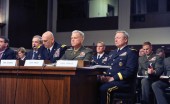‘Trading business cards’ before a disaster
Written by Master Sgt. Thomas Kielbasa // March 25, 2010 // Feature Stories
Nearly 500 participants attend Florida emergency response exercise
CAMP BLANDING JOINT TRAINING CENTER (March 25, 2010) – Hundreds of first responders from more than a dozen federal, state and local agencies are taking part in an emergency response exercise in Florida this week, hoping to integrate their assets and skills before an actual disaster strikes the state.
Nearly 500 people, from agencies including the Florida and the Georgia National Guards, are taking part in “Operation Integration” at Camp Blanding Joint Training Center in North-Central Florida. The exercise simulates the aftermath of a large-scale disaster – similar in magnitude to a 9-11 or Hurricane Katrina event – and challenges the participating agencies to work together in recovery efforts.

Soldiers from the Florida National Guard's CERF-P (Chemical, Biological, Radiological, Nuclear, and High Yield Explosive Enhanced Response Force Package) practice breaking up and removing rubble during the multi-agency Operation Integration exercise at Camp Blanding Joint Training Center, Fla., March 25, 2010. Photo by Master Sgt. Thomas Kielbasa
“The importance of Operation Integration, as far as a training event, is to ensure that we get used to training and working with other first responders from different agencies in keeping with the National Response framework,” explained Florida Army National Guard’s Capt. Gene Redding during the exercise on March 25.
Redding’s team of Guardsmen from the Florida National Guard’s CERF-P (Chemical, Biological, Radiological, Nuclear, and High Yield Explosive Enhanced Response Force Package), was working in tandem with participants from agencies including: the Georgia National Guard, the 44th and 48th Civil Support Teams, U.S. Marine Corps, the Federal Emergency Management Agency, a local sheriff’s office, and several State of Florida emergency response groups.
“In a real world incident this is really going to help us out,” Redding said. “The saying in the response community goes: ‘You don’t want to trade business cards on the scene of a real-world incident.’ So if we’re familiar with how each agency works, if we can put faces with names (and) establish those relationships, it’s only going to make our response effort that much more efficient.”
The Operation Integration scenario simulates multiple improvised explosive attacks on two different areas of a large metropolitan city, and requires a collective response from all the participating agencies. According to the scenario, the St. Johns County Sheriff’s Office initially responds to the incident and serves as the incident command, and requests the follow-on response. The response includes everything from technical search-and-extraction, to mass decontamination and medical triage of civilians.
On March 25, Florida National Guard CERF-P members were practicing those urban search-and-extraction techniques on massive piles of rubble on the west side of Camp Blanding. Under supervision by a team of safety experts contracted for the exercise, the Guardsmen were practicing cutting through metal walls with torches and breaking up chunks of cement – obstacles typically found during extraction missions.
“Training is valuable, regardless of when and where you do it,” said John McLoughlin, one of the contracted instructors for the exercise and a captain with Fort Lauderdale Fire Rescue. “But to get a multi-agency training scenario…is an invaluable practice for the real thing.”
Florida Army National Guard aviators and Florida search-and-rescue teams were also partnering for the exercise; Black Hawk and Chinook helicopters will airlift the civilian search-and-rescue experts onto Camp Blanding. From there the teams will spread out in the “devastated” training area and look for injured citizens.
“This is the first time in Florida that our urban search and rescue systems have trained this closely with the National Guard on this scale,” explained Scott Chappell, program coordinator at Florida State Fire College, who was helping coordinate that part of the exercise. “…It’s something you have to be ready for in the case of a barrier island being destroyed and the only avenue to insert search-and-rescue teams is helicopter. And our National Guard friends are probably our best resource in that.”
###















